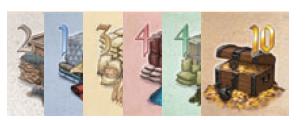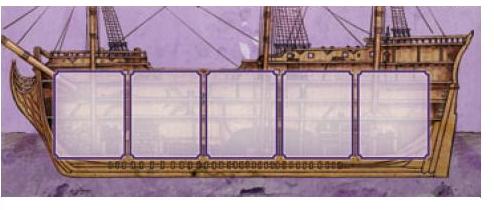
Medici
2-6
10+
45

Game Description
Return to the trading days of the ancient Medici family when ships sailed throughout the Mediterranean and beyond. Bid at the markets for the best prices on valuable and not so valuable goods. Corner the market on a commodity and reap additional rewards. Fill your ship and set sail for foreign markets where your goods will fetch high prices. After three trips to the market, the player with the most money wins!

image © Rio Grande Games
User Reviews (3)
Add a Review for "Medici"
You must be logged in to add a review.

Medici is game where players take on the roles of Italian merchants bidding for goods at the marketplace and filling up their ships with the goods. Reiner Knizia is a master of subtle strategy, and this game shows especially when you add more players.
PROS:
Plays fast
Great and intense with more players
CONS:
Dry with 3 players.
Average components
GAMEPLAY:
The gameplay is fairly simple and is played in three rounds (days). Each player takes a boat and tokens, then the active player draws 1 to 3 tiles which represent goods in the market. Once the tiles are drawn and placed, each player then takes a turn bidding on the lot of tiles from left to right ending with the player who drew the tiles. These tiles are used to fill up the players boats. Once a player’s boat is filled, they cannot bid until the next round. When the bidding is complete, the next player one left draws more tile and more bidding begins. When everyone’s boats are filled, then the day (round) ends and scoring begins.
The scoring based on the point value of the goods and how many goods the player put in their boat. Whoever got the most point value of goods will get a 30 florin bonus, then other lesser bonuses handed to other places down to no florins for last place. Then the tokens are moved in each market for the goods on the tiles, and there are bonuses for people with the most and second most of a good on the market pyramids. If you can get your marker to the top of the pyramid, you score yet another bonus. After scoring is complete, the poorest player starts the round by drawing tiles.
CRUX:
The meat of the game comes down to two things: jockeying for position to get the most points for a round and getting the most (monopoly) of a certain set of goods by the end of the game. The sooner you secure a monopoly in a good, the more the bonus counts as it’s added per round. You really have to watch and keep up with the goods that everyone is getting, because you need to know who may be challenging you in the same good and know how to spoil the market for someone based on what’s in their boats. The bidding can get really tense sometimes when trying to secure the goods you need versus the bonus for the round.
CONCLUSION:
I found this game quite refreshing the first time I played it. I was fortunate to start with six players playing the game, and it really made it fun. As the game wore on, I noticed how this game could really get boring with 3 players, because there is less strategy and competition over bidding on the goods. This game really needs close to the maximum number of players to keep it interesting. The intensity ratchets up while watching everyone’s progress and figuring out how to win bid of a batch of goods you need. Sometimes you get stuck trying to decide if you need to bid on some low value goods and sacrifice the round bonus, just so you can secure a monopoly in that good.
This game seems well suited for casual and social gamers, because it is easy to play and has a lot of player interaction in the bidding wars. I don’t think power gamers will in enjoy it, because there isn’t a lot of depth to the game beyond the number of people playing and no overall long-term strategy. Avid gamers and family gamers with older children should still give it a try.
Try it it, you just might like it.
This is a tight game where most of the strategy emerges from player choice, which is great. It’s pretty simple, however.
Every turn is the same: The current player takes one, two, or three tiles from a bag, then everyone gets ONE bid on how much they’d pay for those goods, with the current player bidding last. Then the bag is passed.
Once everyone’s boats are full with 5 goods, the players receive money based on how much their goods are collectively worth. The goods are then essentially sold for profit, and the value of the goods increases by how many the player has sold so far, rewarding set collecting.
The key is to not overbid on low value goods, and not to underbid high valued goods so that other players can scoop them up for a pittance.
Lots of player interaction, although the action is of one type: bidding.
This game centers itself almost entirely around the bidding mechanic.
It’s a mechanic used in many other games, but usually as a slightly more minor aspect of the game. Here, it’s 95% of the game.
It’s a fun, quick game to play with gamer friends, but I really don’t know anyone who goes “Oh, man! Medici! Yeah, let’s rock that!”
If I saw it at a yard sale, I’d pick it up, but I wouldn’t choose it as a new game to add to my collection.